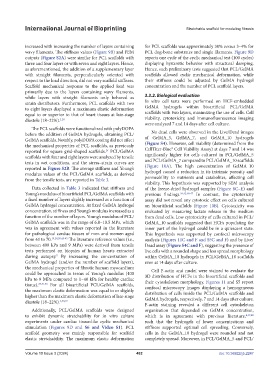Page 490 - IJB-10-3
P. 490
International Journal of Bioprinting Stretchable scaffold for modeling fibrosis
increased with increasing the number of layers containing for PCL scaffolds was approximately 30% versus 3–4% for
wavy filaments. The stiffness values (Figure 9B) and FEM PCL dog-bone substrates and single filaments. Figure 9D
outputs (Figure S2A) were similar for PCL scaffolds with reports one cycle of the cyclic mechanical test (100 cycles)
three and four layers or with seven and eight layers. Hence, displaying hysteretic behavior with structural damping.
as aforementioned, the addition of a supplementary layer Hence, such preliminary tests suggested that PCL/GelMA
with straight filaments, perpendicularly oriented with scaffolds allowed cyclic mechanical deformation, while
respect to the load direction, did not vary scaffold stiffness. their stiffness could be adjusted by GelMA hydrogel
Scaffold mechanical response to the applied load was concentration and the number of PCL scaffold layers.
primarily due to the layers containing wavy filaments,
while layers with straight filaments only behaved as 3.3.2. Biological evaluation
strain distributors. Furthermore, PCL scaffolds with two In vitro cell tests were performed on HCF-embedded
to eight layers displayed a maximum elastic deformation GelMA hydrogels within bioartificial PCL/GelMA
equal to or superior to that of heart tissues at late-stage scaffolds with two layers, minimizing the use of cells. Cell
diastole (18–22%). 5,20 viability, cytotoxicity, and immunofluorescence imaging
were analyzed 7 and 14 days after cell culture.
The PCL scaffolds were functionalized with polyDOPA
before the addition of GelMA hydrogels, obtaining PCL/ No dead cells were observed in the Live/Dead images
GelMA scaffolds. Notably, polyDOPA coating did not affect of GelMA_5, GelMA_7, and GelMA_10 hydrogels
the mechanical properties of PCL scaffolds, as previously (Figure S4). However, cell viability (determined from the
reported for square grid-shaped scaffolds. PCL/GelMA CellTiter-Blue® Cell Viability Assay) at days 7 and 14 was
24
scaffolds with four and eight layers were analyzed by tensile significantly higher for cells cultured in PCL/GelMA_5
tests in wet conditions, and the stress–strain curves are and PCL/GelMA_7 compared to PCL/GelMA_10 scaffolds
reported in Figure S2B. The average stiffness and Young’s (Figure 10A). The high concentration of GelMA_10
modulus values of the PCL/GelMA scaffolds, as derived hydrogel caused a reduction in its intrinsic porosity and
from the tensile tests, are reported in Table 3. permeability to nutrients and catabolites, affecting cell
viability. This hypothesis was supported by SEM analysis
Data collected in Table 3 indicated that stiffness and of the freeze-dried hydrogel samples (Figure 8C–E) and
Young’s modulus of bioartificial PCL/GelMA scaffolds with previous findings. 34,42,46-47 In contrast, the cytotoxicity
a fixed number of layers slightly increased as a function of assay did not reveal any cytotoxic effect on cells cultured
GelMA hydrogel concentration. At fixed GelMA hydrogel on bioartificial scaffolds (Figure 10B). Cytotoxicity was
concentration, stiffness and Young’s modulus increased as a evaluated by measuring lactate release in the medium
function of the number of layers. Young’s modulus of PCL/ from dead cells. Low cytotoxicity of cells cultured in PCL/
GelMA scaffolds was in the range of 6.8–10.5 MPa, which GelMA_10 scaffolds suggested that HCFs populating the
was in agreement with values reported in the literature inner part of the hydrogel could be in a quiescent state.
for pathological cardiac tissues of men and women aged This hypothesis was supported by confocal microscopy
from 61 to 70. 19,20,38,43-45 The literature reference values (i.e., analysis (Figures 11C and F and S5C and F) and by Live/
between 400 kPa and 9 MPa) were derived from tensile Dead assay (Figure S4C and F), suggesting the presence of
tests performed on biopsies of human hearts extracted live cells with a rounded shape and less spread morphology
during autopsy. By increasing the concentration of within GelMA_10 hydrogels in PCL/GelMA_10 scaffolds
5
GelMA hydrogel (and/or the number of scaffold layers), even at 14 days after culture.
the mechanical properties of fibrotic human myocardium Cell F-actin and nuclei were stained to evaluate the
could be approached in terms of Young’s modulus (400 3D distribution of HCFs in the bioartificial scaffolds and
kPa to 9 MPa compared to 1–40 kPa for healthy cardiac their cytoskeleton morphology. Figures 11 and S5 report
tissue). 27,31,38 For all bioartificial PCL/GelMA scaffolds, confocal microscopy images displaying a homogeneous
the maximum elastic deformation was equal to or slightly distribution of cells inside the PCL/GelMA scaffolds and
higher than the maximum elastic deformation of late-stage GelMA hydrogels, respectively, 7 and 14 days after culture.
diastole (18–22%). 5,20,22
F-actin staining revealed a different cell cytoskeleton
Additionally, PCL/GelMA scaffolds were designed organization that depended on GelMA concentration,
to exhibit dynamic stretchability for in vitro culture which is in agreement with previous literature, 4,37,48
experiments under cardiac tissue-like cyclic mechanical such that the hydrogels of lower concentrations and
stimulation (Figures 9D and S6 and Video S1). PCL stiffness supported optimal cell spreading. Conversely,
scaffold geometry was mainly responsible for scaffold cells in the GelMA_10 hydrogel were rounded and not
elastic stretchability. The maximum elastic deformation completely spread. Moreover, in PCL/GelMA_5 and PCL/
Volume 10 Issue 3 (2024) 482 doi: 10.36922/ijb.2247

